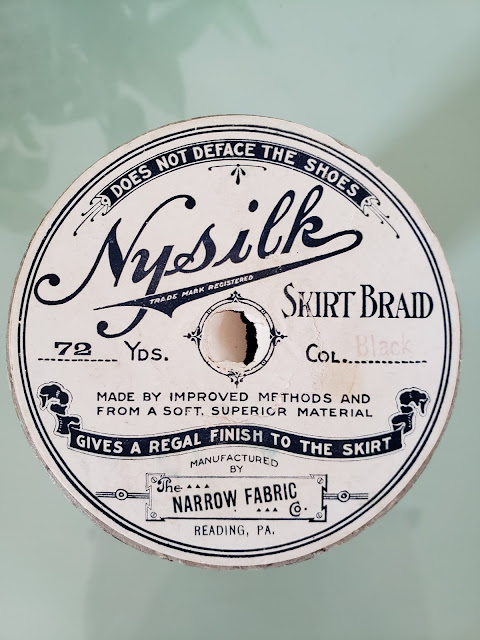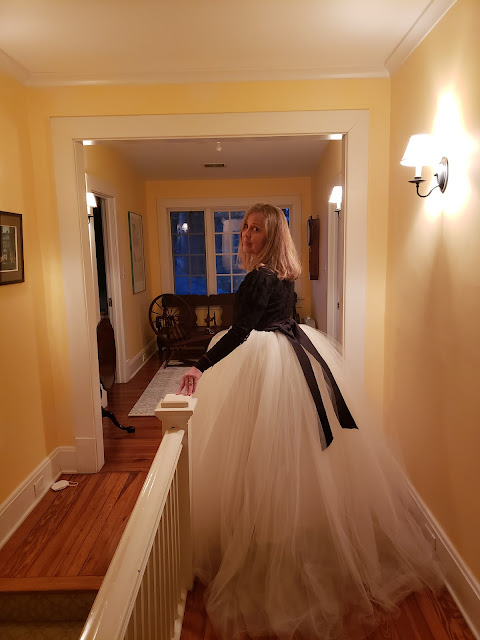 |
| Antique Nysilk brand skirt braid, part of a spool of 72 yards |
Here's an interesting bit of history, sitting on the coffee table this afternoon. It's a large spool of Nysilk brand skirt braid.
 |
| A section of the Nysilk skirt braid |
 |
| The label at the top of the spool of Nysilk skirt braid. The bottom features an identical label. |
No Scratch!
"Does not deface the shoes", the header proclaims in a little banner at the top of the spool. Right off we can estimate that the braid was used on long skirts that regularly brushed the shoe tops. That means it's likely from before 19...say, 1914 and at latest about 1918-19 among more conservative women.
"Made by improved methods and from a soft, superior material". Well, that's more marketing language that doesn't tell us what fiber or fibers are used. "Nysilk" is meant to sound silky and to underscore that the braid wouldn't scratch the shoe tops. It feels like a cotton and sure enough, in 1909 advertisement in The Delineator we learn that it's made of mercerized Sea Island cotton, hence the faint shine and the softness.
 |
| A March 1909 ad for Nysilk skirt braid on p. 472 of The Delineator. |
It's indeed a braided fabric, not a woven one. Here is a closeup, below.
 |
| Closeup of Nysilk skirt braid, showing the braided structure. |
Unless the marketing is pure fluff and the maker, The Narrow Fabric Co., is trying to convince purchasers that other brands of braid will rough up the shoes, then now we know that skirt braid could be scratchy and that a kid or patent or polished or silk finish on the shoes could be hurt by repetitive rubbing by the bottom of the skirt. Few of us like their shoes to look dinged up: most of us who have looked at our feet only to see a fresh scratch across a shoe is familiar with the annoyance it produces, the slight lessening of chic.
A Regal Finish
"Gives a regal finish to the skirt" says the very pretty little ribbon-style banner on the lower part of the spool.
Oh, how I love to read this, for it hints at another of skirt braid's functions. These braids have a a bit of body to them: they're not loosely made or very thin, like so many of today's cotton tapes or bindings that we use in costuming today in all kinds of ways.
Instead they resist just the littlest bit when bent, and the braid unwinds in pretty loops rather than collapses into a flaccid little heap.
Here's the Nysilk skirt braid in action, in the short video below.
Can't see it embedded? Here's the YouTube link: https://youtube.com/shorts/1_
You can guess how this sort of braid will help. Bound to the skirt hem, it will encourage the skirt hem on a long skirt into more handsome ripples. This was done with velvet or velveteen fabric, too, but a pre-made braid is easier to work with. You can rather imagine what it looks like by examining the illustration of the young woman in the Delineator ad. The end result is an improved hemline. Regal? Well...that may be a stretch, but tidier, anyhow.
You find skirt braid often on heavy skirts or wool skirts. One of the skirts in my collection has it in the form of brush braid...an 1890s skirt. That was another decade in which skirt braid was an especially popular thing. I haven't seen skirt braid on Edwardian summer muslin or linen skirts in my collection or in cotton print skirts when I look for it in pictures online. Which is not to say it wasn't used: I just haven't a scrap of evidence.
However, what with a wool or wool mix skirt being a standby for daily wear in women's skirts in all seasons, skirt braid was a common little helper in the sartorial part of many women's day-to-day environments.
Where Did the Spool Live?
The spool holds 72 yards and as we know from the Delineator ad, came in different colors to best blend in with the skirt fabric, because while this braid is black, and is labeled so on the spool, there's a space labeled "Col", for "color", and the word "black" stamped in a faded red ink in that space.
Who owned the spool? Here I can speculate based on the tear in the label over the hole that runs through the spool, meaning that the spool had likely been strung on a bar, so someone could unreel and cut what was needed. Was the skirt braid an inhabitant of a dressmaker's shop?
The Delineator ad shows that it was sold in small packages of a few yards. This would be convenient for selling in a store to home seamstress purchasers, although larger amounts might be sold from the spool, mounted with other trims and notions in a shop or department store, too.
Here's the printed record, again. A little too laudatory, perhaps, but still: "The main product consists of shoe laces...but a great many skirt braids are made, which can be found on sale in nearly every retail store in the country". (Historical and Biographical Annals of Berks County, Pennsylvania, by Martin Luther Montgomery, 1909, p. 284.) So its original home was likely in a store or dressmaker.
The ad's presence in The Delineator means it was marketed to home seamstresses, but women who purchased skirts readymade that lacked the binding could have it added, as the ad recommended.
About the Maker
The Narrow Fabric Company in Reading, PA was founded by Henry Janssen and Ferdinand Thun in 1900 to make brush braid, elastic for garters, shoelaces and other braids. Built on a first, successful company the pair started in the 1890s, the new company was even more successful. The company was part of what became the Wyomissing Industries, which included Berkshire Knitting Mills, the originator of the fully fashioned hosiery knitting machine.
For those of you interested in the history of textiles, the history of progressive worker relations and of planned communities, see the article "Two Gentlemen of Vision" by Alan Tabachnick in Pennsylvania Heritage" magazine, summer 1991. Sadly, it closed around 1991, a victim of outsourcing and less expensive imports. Its struggle for survival is chronicled in a moving little article blandly titled "Narrow Fabric Closes" in the Reading Eagle newspaper.
Hoping you enjoyed this little foray into the past.
In Other News...
I've examined the Past Pattern's 1901 Reception Gown pattern and have written out the process of making the Edwardian dress in the spots where I am departing from it, or mostly, anyhow, but time is not accommodating. The work schedule is truly fierce currently and significant time is spent ferrying children around or doing summer family things, like trips to the pool and of course, doing my part of the housekeeping. After all that, I'm too pooped to even think of doing anything else. That's okay. This is just a hobby, after all.
Wishing you a happy next few weeks!









































.jpg)
















